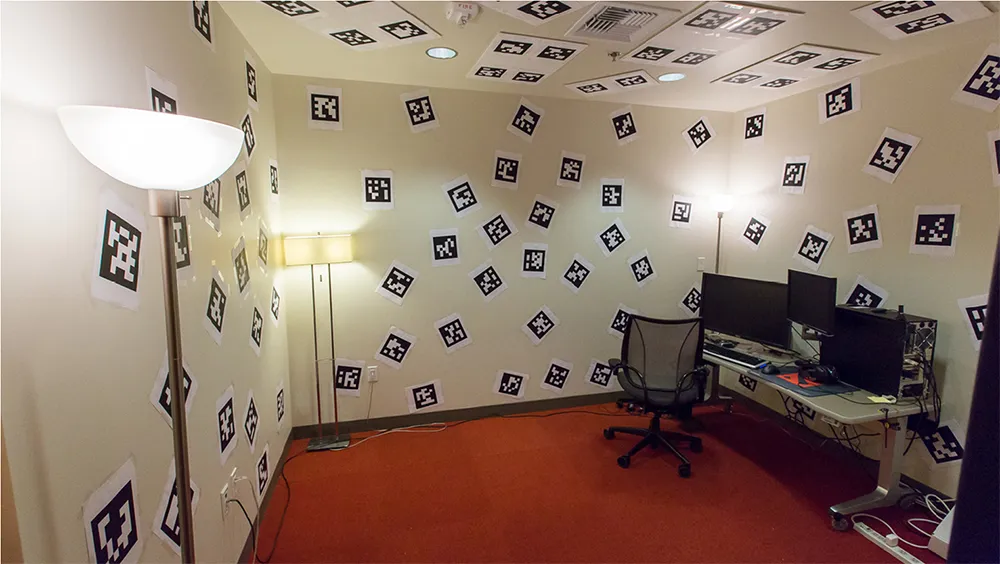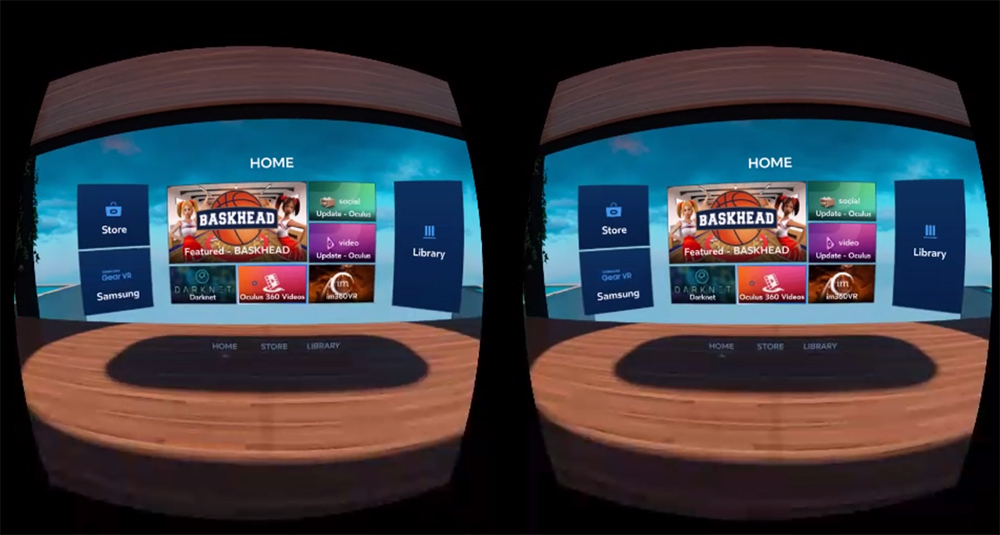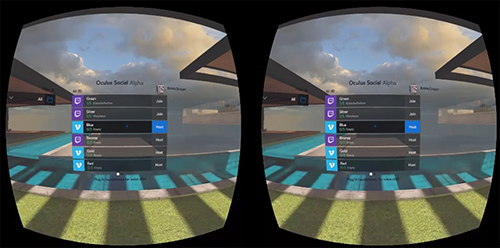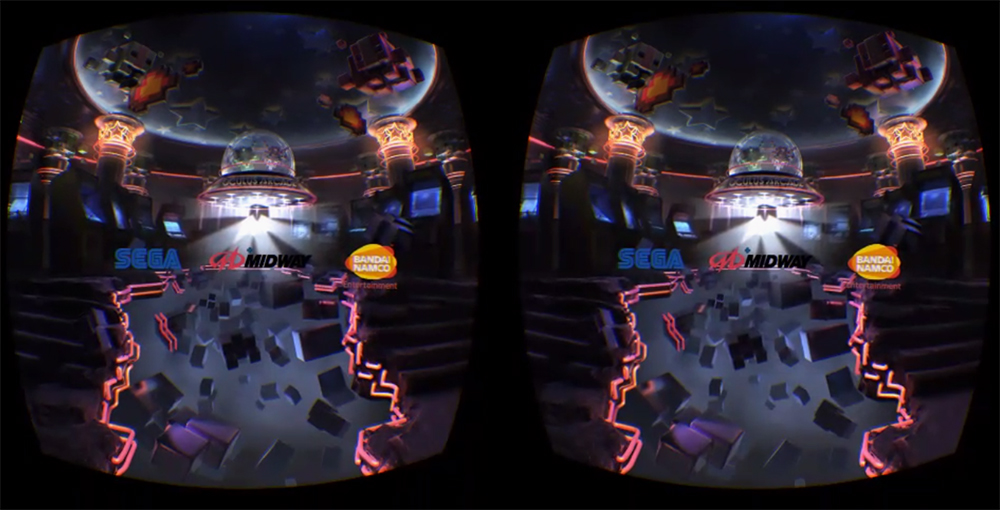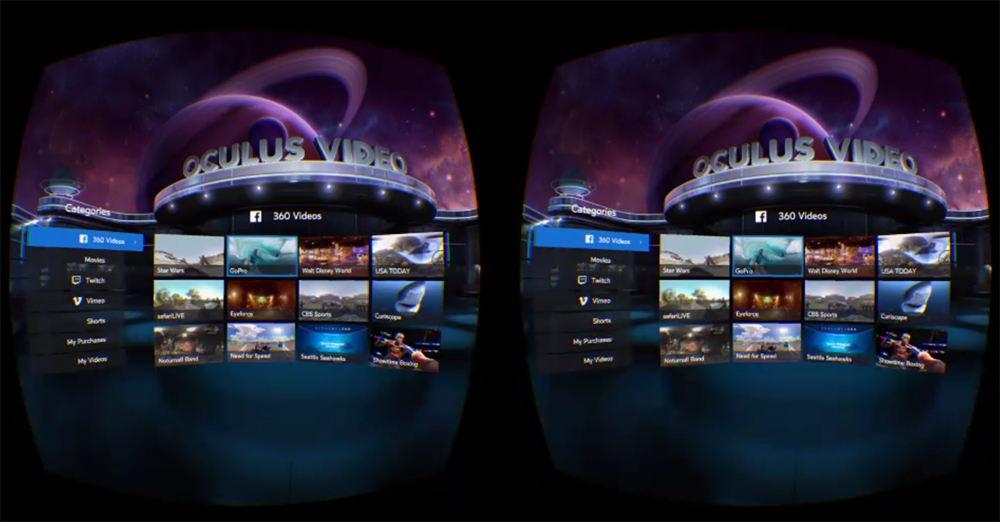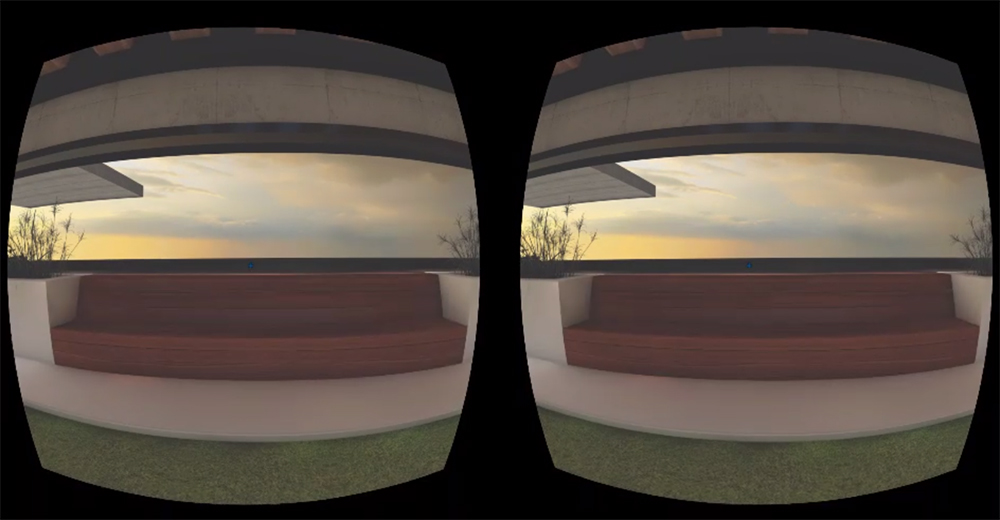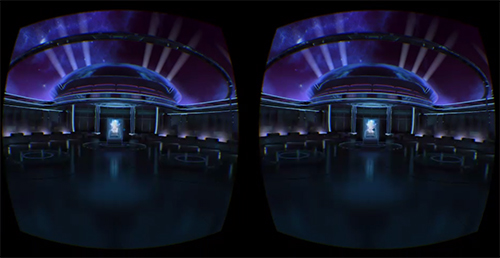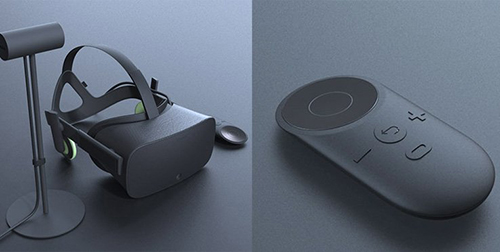“Ahem.”
[ adjusts mic ]
“The Oculus Rift was not designed for room scale VR.”
[ a shoe comes sailing out from the third row punching through drywall, mere inches from the speaker’s head. ]
Um, I want to explore a few ideas here for a moment and I ask that you keep your footwear on your feet if you can help it. This is about two products that I care deeply about, and the curious state we find ourselves in as we head to retail with the Oculus Rift and HTC Vive.
What I want to do here is tell you a little story about Oculus, Valve and HTC and how odd they all really are.
So … let’s start with Oculus …
September 2014, I sat watching John Carmack give his talk during the first Oculus Connect keynote. He stood on stage for a full hour and a half. A great talk except for one small moment which made me spill my coffee all over the only decent shirt I had with me:
“Like Brenden says, ‘We never talk about standing.’”
Right before launching into a praise of swivel chairs, John lets it slip that “standing” is something he was specifically instructed to not talk about.
I remember sitting there more or less floored. Here we were at VR ground zero, the supposed nexus for innovation in the space … and STANDING was a banned topic. This came at a time when most of the audience in attendance had already figured out standing had some kind of multiplier effect on experiencing VR. I remember hearing titters of slightly nervous and confused laughter ripple through the crowd as Oculus continued to push the idea that swivel chairing was the future of VR.
This was less than two years ago.
Speculation at the time classified it as being a legal issue. Some lawyer working for Oculus decided it might be a bad idea if someone stepped off a cliff while wearing a headset, so the company simply COULD NOT be seen as endorsing anything that didn’t have your ass in a chair while using VR.
End of story.
Strangely enough, only hours later that same day, all of the Oculus Crescent Bay demos at Connect were held as standing experiences. It seemed Oculus knew full well they could more easily “wow” people in VR while they stood.
TOUGH LOVE
Let me bounce back even earlier and tell you a little about the Oculus DK2. I have to admit I had very mixed feeling about this device. It was like a teddy bear full of vipers. You never wanted to hug it too hard as it was sure to punish you for your affection.
Below is a diagram of the positional tracking volume for DK2. “Frustum,” comes from Latin meaning: “To be badly frustrated by something you want to love.” If you’ve never used a DK2, you won’t know the maddening hell of losing positional tracking any time you ventured further than the few feet afforded by the tracking camera. Worse still, the tracking area was a cone, so depending on how close you were to the camera, your tracking space got larger or smaller. You never could be too sure your world wasn’t just about to lock up and make you feel like you were dying inside.
I mention the DK2 now and my frustration because it really bothered me on a much broader level. There was something disturbing about Oculus maybe … something that I eventually pinned down to the question of: “Who the hell at Oculus decided THIS tracking volume was good enough?”
For me, the DK2’s tracking volume was always this terrible taunt to the end user. It showed you a glimmer of what was possible, but just a small glimmer and nothing more. I can’t even explain it away with “it’s a development kit, what do you expect?” as it really didn’t afford developers a decent working preview of the large tracking volumes that are now hitting retail.
In the back of my mind since the DK2 I have this concept of a shadowy figure who works at Oculus making really bad decisions about important things. I also suspect this person is one in the same with whoever it was that thought showing the health and safety warning was a good idea every time you used the Rift. He looks just like the Smoking Man from the X-Files.
“The DK2 tracking area is fine, ship it. A cardboard box is also fine for those fuckers, ship it.”
This “smoking man” is a person whose whole being is focused on the practical business end of things and does not really give a fuck about VR at the end of the day. The folks at Oculus seem like reasonably good, invested people, so it is handy to have an imaginary scapegoat to blame things on.
Want to know something else Oculus Smoking Man is responsible for? Let’s bounce back to present day.
THE ERA OF PASSIVE VR
The Samsung/Oculus Gear VR was modern VR’s very first toe dip into retail. It got there first and for many people it was their very first VR experience. Unlike anything encountered before, suddenly people had a media device that could be used to look all the way around themselves in 360-degrees. Wondrous.
So how did Oculus use this space? Well … take a look …
Here are the nice looking main menus from all of the first party Oculus apps on Gear VR:
Oculus Home
Oculus Social
Oculus Arcade
Oculus Video
Oculus 360 Photos
And here is what you see if you look behind you …
Oculus Home
Oculus Social
Oculus Arcade
Oculus Video
Oculus 360 Photos
“Who the fuck cares if there’s nothing back there? Stop wasting my time. Get out of my office.”
While I am aware a VR developer needs to make it clear where the user should focus their attention, I equally feel there is something quite wrong here. End users should be delighted by what they see in VR, not just by what is up on “the stage.” They should be rewarded for looking around. Why give them a 360 environment to explore if you aren’t going to fill it with things worth looking at? Don’t punish them with boredom for looking around, reward them. Otherwise, what the hell is this all about? Where’s the wonder? Where’s the fun? I’m nit picking you say? Well, maybe. But keep in mind Oculus really is (currently) the ambassador for VR to the world. If anyone is burdened with the responsibility for making VR awesome, it really is them. I expect them to fully embrace the technology at every turn and from every angle. If they aren’t going to do it, who will?
So let me put on my speculation hat on.
Facebook owns Oculus. Facebook is known for having a good track record for leaving their acquisitions to mind themselves, but at the end of the day: Facebook. Owns. Oculus. Facebook has shareholders and got to where it is today by running itself as a proper, practical business. Never forget that.
After the acquisition you might have heard that one of the long term goals for Oculus would be to connect a billion people together in VR. Facebook has managed to do this in 2D, why not 3D? If I sat you down and gave you the business goal of attracting a billion people to something, you are very likely going to go the conservative route and cast around for what already works in traditional media. Vanity Fair ran a great article on Oculus following the acquisition that has a list of what Facebook might want to use VR for:
Games.
News.
Sports.
Movies.
TV.
Cat Videos.
Games were to be just one spoke on the Facebook VR wheel with the majority of the content being traditional media made novel through the new medium of VR.
Now think back over the last few months at the highlight moments for Gear VR: The upcoming partner line up for Gear VR, NBA on Gear VR and the Democratic Debate on Gear VR. Almost all of the loudest noise in consumer VR is being made by products that are passive VR experiences. Finally given a tool that could take humanity anywhere and the greatest push seems to be to put you back on a couch: Your own virtual couch! (Netflix for Gear VR)
The theme I’m seeing here is these are all very practical, business-minded ventures. VR could be the next TV and Facebook could be the gatekeeper.
Do you remember the Oculus images that leaked in summer 2015? In case you don’t, here they are again:
Now, (remember, the speculation hat is still on…) Oculus dismissed these images as being “ancient” and “nowhere close to final” which was all well and good at the time… UNTIL they launched pre-orders this month featuring the same damn remote with every Rift.
Do you know what a controller like this is good for? It is for users to select, start and stop passive media in VR. That’s it. You can’t play a game with it and you sure as heck can’t model clay, paint or shoot a spaceship with it. Imagine these were the ONLY items waiting for you when you opened your retail Rift. What kind of device then did Oculus intend to ship? What is VR to Oculus?
It is entirely possible ‘The Smoking Man” sees the initial Rift as simply a new media consumption device not all that different from the static HMDs that Sony used to sell 10 years ago for watching videos.

“Kids put the fucking thing on their face and watch movies, what else do you want? Ship it.”
–
Does anyone remember what it felt like when the DK2 was announced? There was a lot of talk at the time that you really should hold out for the consumer version of the Rift, as it was “right around the corner.”
Here is Palmer imploring people to NOT buy the DK2. (March 2014)
But… It would take another full two years after the DK2 was announced to launch the first Rift consumer version. Want to know what happened? Valve and HTC came along and fucked everything up.
NICE TO MEET YOU VALVE
Valve is a private company likely earning hundreds of millions of dollars each year through Steam. They have a very comfortable, reliable revenue stream and they don’t answer to anyone. Valve didn’t play by the rules when it came to their interest in VR. When Valve decided to investigate VR, they really didn’t approach it as a business. They deliberately chose to throw practicality out the window and see “how far we could take it.”
Very relevant clip:
Expense was not a consideration. Consumer practicality was also not a consideration. Now in the real and rational world, normally these kinds of experiments end up sitting on a shelf. Something really cool that everyone agrees is “neat” but it never actually goes anywhere. You often end up with something entirely impractical and expensive well beyond your average consumer.
Enter HTC.
There’s a lot of talk right now about how HTC is on the ropes and doing badly. Guess what? This isn’t news to HTC. If you take a peek at their stock over the last five years you can see that none of this is new and the popular solution at HTC to resolve this probably wasn’t: “Let’s beat Apple and Samsung at their own game with an even better phone!”
They did however have some extremely good years back in 2011-12 and are sitting on a large cash reserve. So, HTC has a pile of resources and manufacturing plants on standby and they also happen to have an office located near Valve in Seattle. I wasn’t there so I can’t comment but I imagine the conversation went like this:
[HTC takes off Valve’s prototype headset after running through the Valve VR demo.]
HTC: “Oh my God. That was amazing, that was unlike anything we’ve ever seen. Consumers are going to love this.”
Valve: “Yes, we think VR is going to be great.”
HTC: “When do we start??? When do we build this?”
Valve: “Well, this is just a prototype… we are still..”
HTC: “How about right now??? Hold on let me call Taoyan.”
Valve: “We aren’t sure about how easy this will be to deploy … and the cost might be … um …”
HTC: “Shhhhh… I can’t hear the people at Taoyan.”
Valve: “Um…”
HTC: “ OK, the factories are booked. They’ve already started dismantling the phone assembly lines.”
Valve: [ shrug ] “Ok, fine, it’s your dime.”
So with all due respect I think Valve is a little crazy and I also suspect, given the circumstances, HTC is a little crazy. And now they are working together. So then, try to imagine the surprise when, in March 2015, Oculus suddenly finds itself thrust from being undisputed King of VR to being in a motion controller knife fight with two crazy people.
A surprise announcement from HTC announcing something completely unreasonable: A room scale VR solution with fully tracked motion controllers ready to go, designed by mad men without compromise and backed by a manufacturer with nothing to lose except absolutely everything.
“Well fuck,” says Oculus.
Let me just put that leaked Oculus photo here once more, I think that’s the third time …
Sigh. You see, all Oculus wanted was to release a great VR headset with a nice store that let you buy games, news, sports, movies and TV. You don’t need room scale for that. You don’t need touch controls for that either. None of this room scale stuff really helps customers sit back and enjoy cat videos in VR. Oh the terrible blinding headache for Oculus. The stupid motion controls that everybody suddenly expects now. Oh and what … now they want walk around their WHOLE room TOO?!?!
Suddenly, overnight, everyone is asking Oculus about their motion controller solution, about their room scale solution. Things that were easily brushed off with a few words before, “input is hard,” are now in the spotlight and everybody wants answers.
If the Oculus Rift and camera costs $600 to make, there is no way that Oculus could go to market at that “high” price without having an answer to input. No way in hell… and Christmas 2015 was coming…
By June Oculus put together a deal with Microsoft to include their Xbox controller and had a prototype of their “Half moon” input controllers ready to show. So Oculus stalls, holds off the launch. They regroup and by September 2015 they have half moon controllers available for demo at Connect 2. So far so good! Now for the real pain in the ass part… and a spoonful of reality that they still haven’t quite fed us yet.
The first Oculus Rift was never designed for room scale VR. There’s no indication that this was ever part of Oculus’s plan. It works reliably for a 4×4 foot square of standing space. This means you can stand, crouch and take a single step in any direction as we’ve seen from demos Oculus sets up at shows. I expect with clever camera positioning this space get slightly bigger with time, but don’t expect to be exploring several meters of space in all directions.
Don’t expect Oculus will have their own version of chaperone mapped to your physical walls. This isn’t going to happen and if it does, Oculus will be kicking and screaming the whole way until we get to that point. While the tracking area is much, much, much larger than the DK2, there are some fundamentals to optical tracking that have to obey simple laws of physics. Here are a few:
- As you approach the camera, the tracking volume decreases in size. You might lose your head and you might lose your feet depending on the angle.
- As you move away from the camera, the reliability of the tracking decreases.
Here is a diagram of a really small man or a really big DK2 camera to help illustrate:
Multiple cameras will help but no matter what, you will always be juggling limited cones of vision.
If you’ve experienced Oculus/Unreal’s ‘Bullet Train’ demo, with Touch, or Toybox you’ll know that you can have a very rewarding, very intense experience within this much space. There are going to be amazing experiences for Oculus but…we need to wake up to the realization that we are NOT heading into a seamless, interchangeable 1:1 VR ecosystem with Rift and Vive. Some room scale titles for Vive will not work in the available space for Rift. If a developer wants to support both devices they will need to scale it to fit the 4×4 space of the Rift and favor the 180 degrees that face toward the camera.
The sooner Oculus makes the exact dimensions of their tracking available to developers the sooner we can drop the fussy expectations and developers can properly plan for cross platform deployment.
Follow Robert McGregor on Twitter, @ID_R_McGregor

